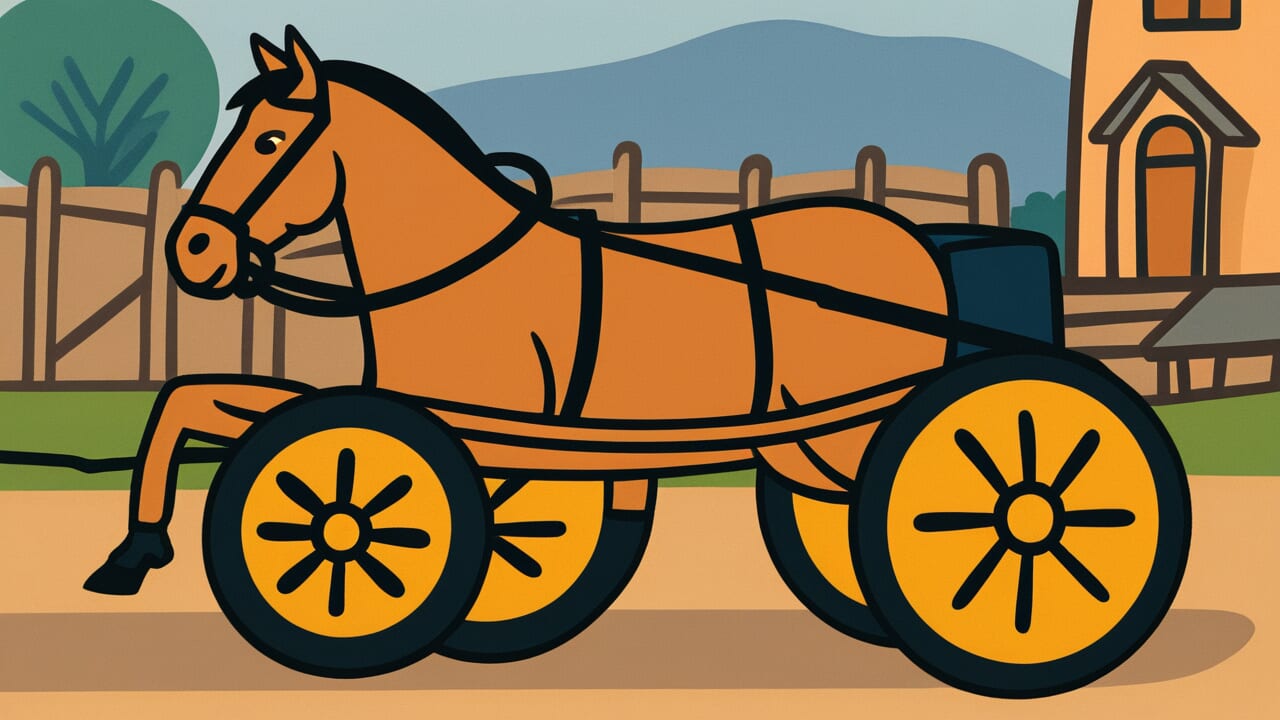How to Read “Don’t put the cart before the horse”
Don’t put the cart before the horse
[DONT put the CART be-FORE the HORSE]
All words are common and easy to pronounce.
Meaning of “Don’t put the cart before the horse”
Simply put, this proverb means you should do things in the right order, not backwards.
The literal image shows a cart placed in front of a horse. This makes no sense because horses pull carts from behind. If you put the cart first, nothing moves forward. The deeper message warns against rushing ahead without proper preparation. It reminds us that some things must happen before others can work.
We use this saying when someone skips important steps. A student might want good grades without studying first. Someone might plan a wedding before getting engaged. A person might spend money they haven’t earned yet. In each case, they’re putting the cart before the horse. The natural order gets mixed up.
What’s interesting about this wisdom is how often we ignore it. We get excited about results and forget about the process. We want the destination without taking the journey. This proverb gently reminds us that shortcuts often lead to problems. Some things simply can’t be rushed or rearranged.
Origin and Etymology
The exact origin is unknown, but this saying has been around for centuries. Early versions appeared in English writing during the 1500s. People have been using similar phrases about proper order for even longer. The image made perfect sense to people who used horses and carts daily.
During those times, transportation depended on animals and simple vehicles. Everyone understood how horses and carts worked together. Putting things in wrong order wasn’t just silly – it was impossible. This practical knowledge made the saying instantly clear. People could picture the problem right away.
The phrase spread because it captured a universal truth about sequence and logic. As societies changed, the meaning stayed relevant even when horses became less common. The saying traveled through books, conversations, and everyday use. Today, most people understand it even if they’ve never seen a horse-drawn cart.
Interesting Facts
The word “cart” comes from Old Norse, meaning a wheeled vehicle. Horse-drawn transportation was so important that many languages have similar sayings about proper order. This proverb uses a simple visual metaphor that makes abstract ideas concrete and memorable.
Usage Examples
- Manager to employee: “You’re planning the launch party before we’ve finished the product – Don’t put the cart before the horse.”
- Coach to player: “You’re celebrating victory but we haven’t won the game yet – Don’t put the cart before the horse.”
Universal Wisdom
This proverb reveals a fundamental tension in human nature between patience and eagerness. We naturally want results quickly, but reality operates on its own timeline. Our brains are wired to imagine outcomes and feel excited about possibilities. However, the physical world requires step-by-step processes that can’t be skipped.
The wisdom addresses our tendency to confuse cause and effect. We see successful people and want their achievements without understanding their journey. We observe happy relationships and forget about the trust-building that came first. This mental shortcut happens because our minds focus on visible results rather than invisible preparation. The proverb reminds us that every effect has a cause, and causes must come first.
What makes this truth impossible to ignore is how consistently it plays out in real life. When we rush the process, things fall apart. When we skip foundations, structures collapse. When we ignore prerequisites, we fail to achieve our goals. This pattern repeats across every area of human experience because it reflects how the world actually works, not how we wish it worked.
When AI Hears This
Humans consistently focus on what they can see and touch. The cart represents the visible goal or final product. The horse represents invisible foundations like skills, relationships, and preparation. Our brains naturally skip over these hidden requirements. We notice the successful restaurant but miss years of recipe testing. This happens because visible things feel more real and important.
This pattern reveals how human thinking actually works in daily life. Our eyes dominate our decision-making process more than we realize. When planning projects, we imagine the finished result first. The boring groundwork feels less exciting and gets pushed aside. This creates a predictable cycle of rushed beginnings and surprised struggles. We treat invisible work as optional when it’s actually essential.
This visual bias actually makes perfect sense from a survival perspective. Humans needed to spot immediate opportunities and threats to survive. Focusing on visible, concrete things kept our ancestors alive and fed. The same brain wiring now makes us chase shiny outcomes. This ancient programming creates modern planning problems, but it also drives human ambition and hope.
Lessons for Today
Living with this wisdom means developing patience with natural sequences. The challenge lies in our excitement about goals and our impatience with preparation. Understanding proper order helps us plan better and avoid frustration. When we feel tempted to skip steps, we can pause and ask what needs to happen first.
In relationships, this wisdom prevents us from demanding trust before earning it or expecting intimacy without building connection. In work, it reminds us to learn skills before seeking promotions or to save money before making purchases. In personal growth, it encourages us to practice basics before attempting advanced techniques. Each area has its own natural progression that works best when respected.
The key insight is recognizing that proper sequence isn’t just about rules – it’s about effectiveness. Things work better when done in order because each step prepares for the next one. This understanding transforms patience from a burden into a strategy. We can embrace the process knowing that each stage serves a purpose, even when progress feels slow.



Comments